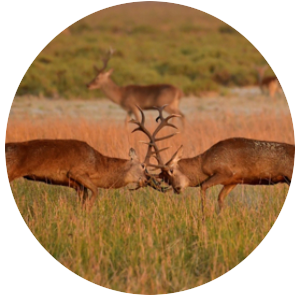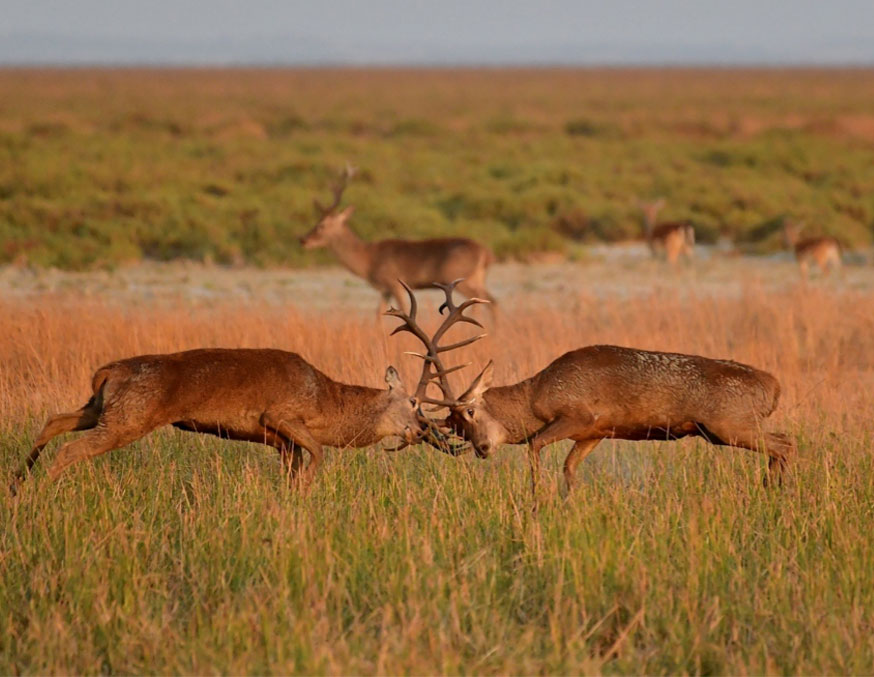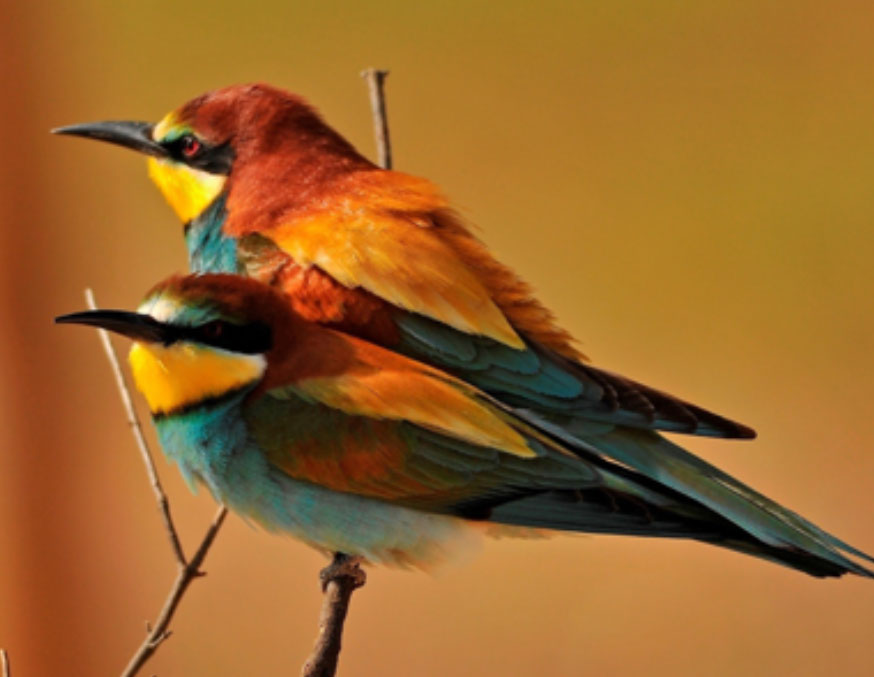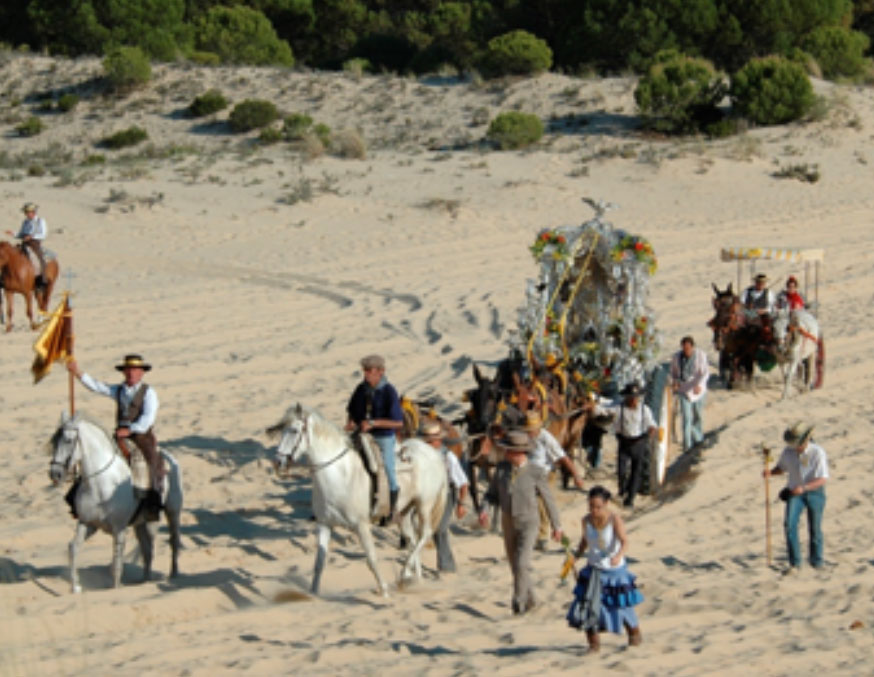

“Cotos” is the name given to a large series of areas with mostly stabilised sandy soil and flourishing plant life, whether these plants are shrubs or those typical to scrubland, pastureland or a com-bination of both.
This is where most of Doñana’s herbivores and predators are found: the red deer, fallow deer, wild boar, rabbit, shrew, garden dormouse, weasel, polecat, ichneumon, genet and wildcat. It is also the territory of two of Doñana’s most emblematic animals, the Iberian imperial eagle and the Iberian lynx, and the cotos are one of their last refuges in the world.
Plant life in the cotos of Doñana has changed considerably over the past few centuries. If you look at documents in the Archive of the Ducal Palace of Medina Sedonia, you can see that in the 17th century Doñana was an open Mediterranean forest where, for example, savin juniper (Juniperus phoenicea subsp. turbinata) dominated the driest zones together with large-fruited juniper (Juni-perus oxycedrus subsp.macrocarpa) that stabilised what are today mobile dunes. In turn, cork oak forests covered 18% of the land and 21% was heather; these plants dominated the moderately damp soil. Today, these species represent 2% and 9% of the land respectively.
Now the most abundant tree inDoñana is the stone pine tree (Pinus pinea) and its origins are very well known. They were originally part of experimental planting carried out in 1737 and subse-quently became widespread as a means to obtain some form of benefit (wood, pine cones, etc.) from a land that was unsuitable for other types of exploitation.
Although this is just one example of ways that man has disturbed the land here over time, it could be said that the cotos that are present in Doñana today are the result of a balance between an ecosystem’s ability to regenerate and regular and persistent disturbances by man.
Most abundant tree in Doñana that dies as it is buried by the advancing mobile dunes.
Usually accompanies the stone pine trees because its seeds are dispersed by birds. It was once used to provoke abortions but is actually poisonous.
The defining scent and colour of these lands with a characteristic inflorescence. It has calming properties and is used to make an essential oil that has beneficial health properties.
One of the main shelters of the Iberian lynx, it is resistant to drought and smaller fires.
Can be heard during its mating season close to El Acebuche Visitors’ Centre. It grows new antlers each year.
The long teeth seen on males are canine teeth rather than tusks.
One of the emblematic species of Doñana and the Iberian Peninsula. Its population is returning thanks to support from breeding in captivity.
Famous in Doñana for being in danger of extinction. It is recognised by its white shoulder bands and unusual wingspan.
When you think of somewhere that has been made a National Park, you imagine somewhere that is a unique enclave with a grand or spectacular landscape. In terms of Doñana, the former is cer-tainly true, but you have to work a little harder to see the latter. Its flatness, aridity at certain times of year and the apparent monotony of its landscapes can make it hard to appreciate its beauty. You could say that it reveals its charms little by little, and only if you take the time to carefully unravel its mysteries and clues, slowly capturing the essence of this nature reserve and the fascinating relationship between its living inhabitants and the physical environment. This is one of Doñana’s main attractions. Let yourself be swept up by it and join the countless other travellers who have been overwhelmed by its magic and its unique and authentic beauty. Sdad. Coop. And. Marismas del Rocío “Doñana Visitas” hopes to share fundamental knowledge about the park with you so that you can appreciate its defining features.

Rutting: one of the most spectacular sights to enjoy in Doñana National Park, this natural phe-nomenon takes place from the middle to the end of August.
When the intense midday heat makes way for an evening breeze, red deer come down from dense thickets to the clearings and pastures of the vera.
Stags bellow their might to the world to draw herds of hinds to their side, jealously defending their family until spring when the hinds give birth to beautiful fawns.

Birds await the long-desired rains that flood the marshland, turn the forests green once more and sate the park’s thirst.
These birds are totally dependent on the level of flooding in this vast water plain for successful breeding; the scale of migration to Doñana is impressive and over 200,000 migratory birds pass through the zone each winter.

Geese arrive in Doñana’s marshland in winter when the cold temperatures in northern Europe freezes the fields where they feed. They are drawn to the gentle winter climate of Huelva’s wet-lands.
Geese feed on sedge roots that grow underwater in the marshes but are hard to digest. To help, the geese swallow sand before feeding; the sand works like sandpaper in their gizzard, making the roots easier to process.
And then the show begins! The break of dawn alerts the geese that it’s time to fly up to the hill that bears their name.

Spring is the moment life returns to Doñana, the days are longer, the temperatures are milder, an-imals awaken after months of lethargy, flowers inundate the landscape with brilliant colours and the sounds of nature fill the air.
In the marshes you can hear Western swamphens grunt while little grebes trill and Eurasian coots squawk in more open waters. Streaked fantail warblers circle the skies above, adding to the scene with their piercing cries.
Flamingos honk, black kites whistle and Imperial eagles give a dry bark as they soar over the pine trees.

This bird starts to appear at the end of March or the beginning of April. They visit in groups of 25-30 birds and are rarely seen travelling solo. Their unmistakeable song is instantly recognised by anyone familiar with it, alerting bird-watchers to scan the skies.
The European bee-eater is definitely one of the most eye-catching birds in these latitudes and pho-tographers and birders enjoy spotting them each year.

Each year, on the weekend of Pentecost Sunday, the village of El Rocío is visited by an immense number of pilgrims who have travelled with their brotherhood on foot, horseback or wagon to pay tribute to the Virgin of El Rocío. The celebration culminates on Sunday to Monday night, the mo-ment of “el salto a la reja” when the procession of the Virgin begins.
El Rocío is the most famous jewel of Doñana, a village with the air of an old settlement by the sea where the waters of the marshlands slowly pool.

This tradition can be traced back to an order issued in 1504 by the Duke of Medina Sidonia and the Asociación Nacional de Criadores de Ganado Marismeño has preserved it until the present day.
La Saca de las Yeguas is, broadly speaking, a farming activity that involves bringing in the marismeño horses that have spent the year grazing and breeding in different areas inside Doñana Nature Reserve and taking them to Almonte for the three-day Livestock Fair.
Once there, in the Huerta de la Cañada enclosure, yegüerizos, specialists in this breed, do the work needed to improve the well-being of these valuable animals, which are unique to the Doñana marshland ecosystem and are in danger of extinction. Once the fair has ended, the animals are returned to their environment where they remain living in freedom until the following year.
